 |
 |
 |
| |
HIV Incidence and Adherence in DREAM -An Open-Label Trial of Dapivirine Vaginal Ring - 2016 / 2018
|
| |
| |
below is the link to the 2016 webcast & the NEJM publication followed by the presentation at CROI 2018, Scroll down to see the full presentation by Zeda Rosenberg following these 2 Conclusion & Summary slides from her talk and links to the webcasts by her & Jared Baeten on his presentation on a dapivirine study and the publication of the original study results.
Zeda F. Rosenberg, ScD
Annalene Nel, Neliettevan Niekerk, Ben Van Baelen The IPM 032/DREAM Study Team
Reported by Jules Levin
CROI 2018 March 4-7 Boston, MA
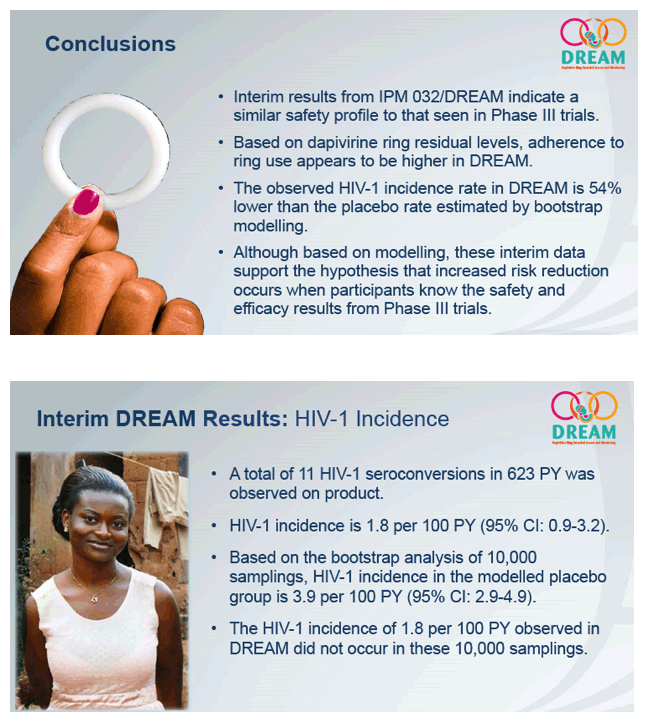
Program Abstract:
The monthly Dapivirine Vaginal Ring (DVR; 25 mg) was evaluated for safety and efficacy in two Phase III clinical trials, The Ring Study and ASPIRE. The trials demonstrated that the ring was safe and reduced the risk of HIV-1 infection in women, 18 to 45 years, by ≅ 30% relative to placebo. DREAM is an ongoing Phase IIIb, multi-center, open-label follow-on trial to The Ring Study to evaluate continued safety and adherence to ring use. The preliminary results are presented.
Women who participated in The Ring Study and who were HIV-negative at screening for DREAM were eligible for enrolment at 5 Research Centers (RCs) in South Africa and 1 in Uganda. Monthly RC visits take place up to 3 months after enrolment, whereafter participants continue on a quarterly visit schedule. HIV testing and safety evaluations are conducted at each visit, and used rings are returned for analysis of dapivirine residual levels. HIV-1 incidence was compared descriptively to the rate expected by bootstrap sampling, based on the placebo arm of The Ring Study, selecting 10,000 times for a subset of women matched for RC, age, and presence of a curable sexually transmitted infection (STI) at enrolment.
By September 2017, 900 women were enrolled in DREAM. The median age was 29 years (range: 20-50); 3% were ≤21, 24% were >21 and ≤25; 33% were >25 and ≤30; 21% were >30 and ≤35; and 19% were >35 years. A total of 11 HIV-1 seroconversions in 623 person-years (PY) of follow-up was observed on product: an incidence rate of 1.8 per 100 PY (95% CI: 0.9-3.2). Based on RC, age, and STI distribution of the population enrolled, HIV-1 incidence was expected to be 3.9 per 100 PY (95% CI: 2.9-4.9) in the absence of DVR use. An incidence of 1.8 per 100 PY would be expected to occur with a frequency of less than 1 in 10,000 samplings. Only 4% of returned rings had a residual level >23.5 mg, indicative of non-adherence to ring use, compared to 17% in The Ring Study. Eleven serious adverse events were reported, all unrelated to ring use.
Preliminary results from DREAM indicate a similar safety profile of DVR to that observed in Phase III. Based on dapivirine ring residual levels, adherence to ring use is higher. Although interpretation is limited by the lack of a placebo arm, the observed HIV-1 incidence rate is ≅ 54% lower than the expected rate in the absence of access to DVR, supporting the hypothesis that increased efficacy would occur when participants knew the DVR's safety and efficacy from Phase III.
2016 WEBCAST: http://www.croiwebcasts.org/console/player/29585?mediaType=podiumVideo&
Safety and Efficacy of Dapivirine Vaginal Ring for HIV-1 Prevention in African Women
Annalene Nel
International Partnership for Microbicides, Paarl, South Africa
2018 WEBCAST: http://www.croiwebcasts.org/console/player/37319?mediaType=slideVideo&&crd_fl=1&ssmsrq=1520863237948&ctms=5000&csmsrq=971
2018 Webcast - Jared Baeten - HIGH UPTAKE AND REDUCED HIV-1 INCIDENCE IN AN OPEN-LABEL TRIAL OF THE DAPIVIRINE RING (ABSTRACT 143LB)
Of note Baeten discusses how the development of the dapivirine ring are in early stages of study and development as was PrEP several years ago where open label extensions of initial studies from which we learned a lot were a step in the process leading to where we are now with PrEP, and so we are in that place now with dapivirine where we will continue to learn more, portrayed in these 2 slides from Jared Baeten's presentation..,,,
webcast: http://www.croiwebcasts.org/console/player/37318?mediaType=slideVideo&&crd_fl=1&ssmsrq=1520864641156&ctms=5000&csmsrq=887
CROI: High uptake and reduced HIV-1 incidence in an open-label trial of the dapivirine ring (03/08/18)
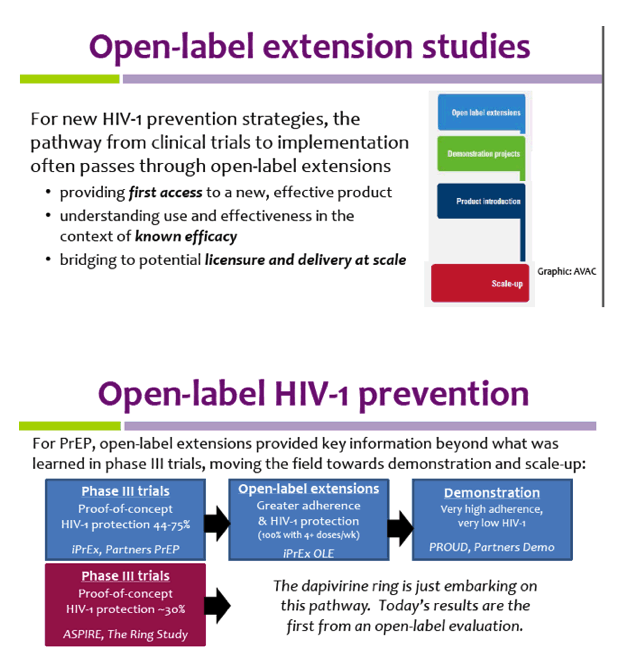
-------------------------------------
Published NEJM Dec 1 2016. Safety and Efficacy of a Dapivirine Vaginal Ring for HIV Prevention in Women. Annalene Nel, M.B., Ch.B., Ph.D.
Pdf attached'
Efficacy. HIV-1 Incidence Rate
HIV-1 incidence rates that were based on seroconversions (confirmed trial end points) are shown in Table 2 and in Figure S6 in the Supplementary Appendix. The overall incidence rate was 4.1 seroconversions per 100 person-years in the dapivirine group and 6.1 seroconversions per 100 person-years in the placebo group. The incidence of HIV-1 infection was 31% lower in the dapivirine group than in the placebo group (hazard ratio, 0.69, 95% confidence interval [CI], 0.49 to 0.99; P=0.04). A Kaplan-Meier plot of the time to seroconversion is shown in Figure 2. Results of the three prespecified complementary efficacy analyses are presented in Table 2. The first complementary analysis, which excluded participants from research center 3, showed an HIV-1 incidence rate of 3.6 seroconversions per 100 person-years in the dapivirine group and 5.4 seroconversions per 100 person-years in the placebo group. The rate of HIV-1 infection was 30% lower in the dapivirine group than in the placebo group (hazard ratio, 0.70; 95% CI, 0.47 to 1.05; P=0.08).
In the analysis that censored data from participants in each group who had three or more events of prespecified nonadherence in 1 year, the HIV-1 incidence rate was 3.3 seroconversions per 100 person-years in the dapivirine group and 4.3 seroconversions per 100 person-years in the placebo group (hazard ratio, 0.74; 95% CI, 0.49 to 1.14; P=0.16) (Table 2). The analysis that was based on time-varying product adherence in the dapivirine group (defined by a residual level of ≤23.5 mg of dapivirine in used rings and a plasma concentration of ≥95 pg of dapivirine per milliliter) showed a 29% lower rate of HIV-1 infection during adherent intervals between visits than during nonadherent intervals between visits (hazard ratio, 0.71; 95% CI, 0.42 to 1.22; P=0.21) (Table 2).
Results from a prespecified subgroup analysis that was based on two age groups (≤21 years and >21 years) showed an HIV-1 incidence rate among participants 21 years of age or younger of 6.4 seroconversions per 100 person-years in the dapivirine group, as compared with 8.2 seroconversions per 100 person-years in the placebo group (hazard ratio, 0.85; 95% CI, 0.45 to 1.60) (Table 2). The HIV-1 incidence rate among participants older than 21 years of age was 3.4 seroconversions per 100 person-years in the dapivirine group as compared with 5.5 seroconversions per 100 person-years in the placebo group (hazard ratio, 0.63; 95% CI, 0.41 to 0.97; P=0.43 for treatment-by-age interaction), indicating no significant difference in efficacy of the dapivirine ring between the two age groups.
Dapivirine Resistance Mutations among Participants with HIV-1 Seroconversion
NNRTI resistance mutations occurred in 14 of 77 participants (18.2%) with HIV-1 seroconversion in the dapivirine group and in 9 of 56 (16.1%) with HIV-1 seroconversion in the placebo group (Table S4 in the Supplementary Appendix). The NNRTI mutation E138A was detected more frequently in participants in the dapivirine group than in those in the placebo group (11.7% vs. 1.8%). Other NNRTI mutations occurred with similar or lower frequency in the dapivirine group than in the placebo group.
Discussion
In the Ring Study, the insertion of a dapivirine vaginal ring every 4 weeks was associated with a 31% lower risk of HIV-1 acquisition than was a placebo ring among women at high risk for HIV infection in two countries in sub-Saharan Africa. The cumulative probability curves of the incidence of HIV-1 infection indicated that the prevention benefit of the dapivirine vaginal ring was achieved early in the trial and was sustained. Divergence in the trial groups did not, however, increase over time. This result is in contrast to that observed in the ASPIRE trial (A Study to Prevent Infection with a Ring for Extended Use),10 a multicenter, randomized, double-blind, placebo-controlled, phase 3 safety and effectiveness trial of a vaginal matrix ring containing dapivirine for the prevention of HIV-1 infection in women, in which the benefit from the dapivirine vaginal ring was apparent only after the first 12 months - a finding that was attributed to participants needing time to become comfortable with using the ring.
Analysis according to age group showed a 37% lower rate of HIV-1 acquisition with the dapivirine ring than with the placebo ring among women older than 21 years of age and a 15% lower rate among those 21 years of age or younger (the age effect was not significant). In the ASPIRE trial,10 age was shown to be significantly related to protection against HIV-1 infection, with no protection observed among participants 18 to 21 years of age and with a 56% lower rate observed among participants older than 21 years of age. The lower level of protection that was observed among younger women may be due to physiologic differences in the genital tract of younger women, lower adherence to ring use, more frequent vaginal or anal sex, or a combination of these factors. Further analyses of the data from our trial may shed light on the reasons for the lower rate of protection in this younger cohort.
Measurements of dapivirine in monthly plasma samples and in used rings indicate that most women in the trial used the ring at some time during each month. Although the overall protective effect that was observed with the dapivirine vaginal ring was significant, prespecified adherence analyses that were based on a cutoff of 23.5 mg or less in the residual level of dapivirine in used rings and a concentration of 95 pg or more of dapivirine per milliliter of plasma did not show increased protection. Previous trials investigating HIV prevention have shown relationships between adherence to the regimen and HIV-1 protection,11-13 and a similar outcome was anticipated in this trial. However, the prespecified criteria that were based on plasma concentrations and residual levels of dapivirine in the used rings may not be the most appropriate criteria for assessment of adherence. Both criteria have substantial limitations.
Pharmacokinetic studies have shown that plasma levels rise rapidly after insertion of the dapivirine vaginal ring, because the initial release of dapivirine from the ring follows first-order kinetics. Dapivirine is detectable in plasma as early as 1 hour after insertion of the ring, and average concentrations exceed 100 pg per milliliter within 8 hours.14 Thus, women who may have used the ring intermittently or just before a clinic visit would have a plasma concentration of more than 95 pg of dapivirine per milliliter. Indeed, the requirement of the trial that women remove the used ring at the clinic before inserting a new ring probably contributed to an overestimation of adherence in participants.
The prespecified residual level of more than 23.5 mg of dapivirine in the ring, which was based on data from a phase 1-2 study conducted in sub-Saharan Africa,15was used during the trial to identify the proportion of participants in the dapivirine group who were more than 95% likely to be completely nonadherent to the regimen. However, the median residual level of dapivirine that was observed in the phase 1-2 trial and in two phase 1 trials15,16 as well as in the Ring Study was 21 mg and is, therefore, probably a better indicator of sustained adherence to ring use. An exploratory time-varying product-adherence analysis in which adherence was defined as a residual level of 21 mg or less of dapivirine in the ring showed a rate of HIV-1 acquisition that was 44% (95% CI, 7 to 67) lower during adherent periods than during nonadherent periods. Further analyses of the data from our trial may assist in determining a more appropriate definition of adherence on the basis of objective measures.
Mutations that were associated with resistance to NNRTIs were generally observed with similar frequency in the dapivirine group and the placebo group, with the exception of the mutation E138A, which was observed more frequently in the dapivirine group. The E138A substitution is a polymorphism of HIV-1 subtype C, and although it is associated with rilpivirine and etravirine, two close analogues of dapivirine,17 it is not associated with nevirapine and efavirenz, which are the more widely used NNRTIs in sub-Saharan Africa. The data are consistent with the data from the ASPIRE trial,10 which also showed no significant difference between the dapivirine group and the placebo group in the numbers of participants with NNRTI mutations suggesting antiviral resistance.
No significant differences in the percentage of patients with serious adverse events were seen between the dapivirine group and the placebo group in the ASPIRE trial. Close monitoring for safety in future studies will help clarify these findings.
The incidence rate of 6.1 seroconversions per 100 person-years that we observed in the placebo group occurred in the context of a clinical trial in which all the participants received regular HIV testing and counseling, treatment for sexually transmitted infections, and free condoms. In addition, participants in this trial live in communities in which male circumcision by medical personnel and HIV treatment are widely available.18 Continued high rates of HIV transmission underscore the need for new HIV prevention approaches for women. The protection that was observed in this trial among high-risk women is lower than that shown with once-daily tenofovir or combination tenofovir-emtricitabine oral prophylaxis in men who have sex with men19 and in heterosexual HIV-1-discordant couples.20 However, in two clinical trials of tenofovir and of tenofovir or tenofovir-emtricitabine oral prophylaxis in participants who are similar to those enrolled in our trial, no protection against HIV-1 infection was observed, because of poor adherence to the daily use of the trial drugs.11,12 Similarly, in studies that evaluated microbicides, one study of a vaginal gel containing tenofovir showed evidence of protection from HIV-1 infection,21 but this result was not confirmed in subsequent studies.12,13
The dapivirine vaginal ring was developed to provide discreet, self-initiated, monthly use with the potential for high adherence. Most participants were able to use the ring for some time of each month, as shown by the residual levels in the used rings and by the plasma concentrations. Several studies have identified reasons for nonadherence among female participants in HIV-prevention trials, including concerns about the potential side effects of the product.22-24 Increases in adherence to oral preexposure prophylaxis have been shown in open-label studies,25-27 and similar trials with the dapivirine vaginal ring are ongoing.
------------------------------------
2016 WEBCAST: http://www.croiwebcasts.org/console/player/29585?mediaType=podiumVideo&
Safety and Efficacy of Dapivirine Vaginal Ring for HIV-1 Prevention in African Women
Annalene Nel
International Partnership for Microbicides, Paarl, South Africa
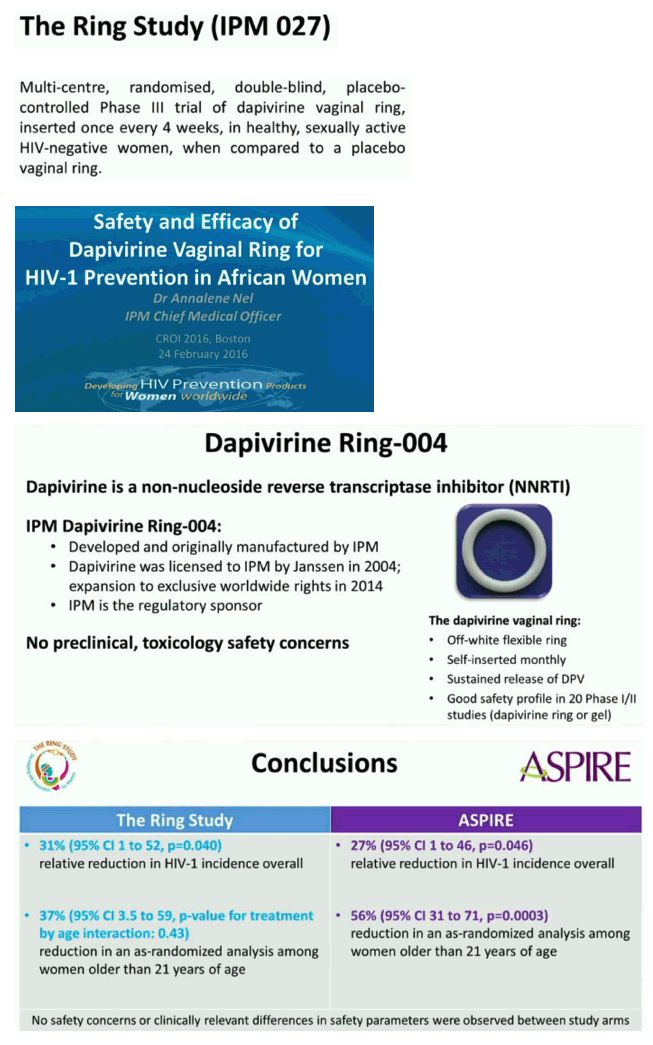
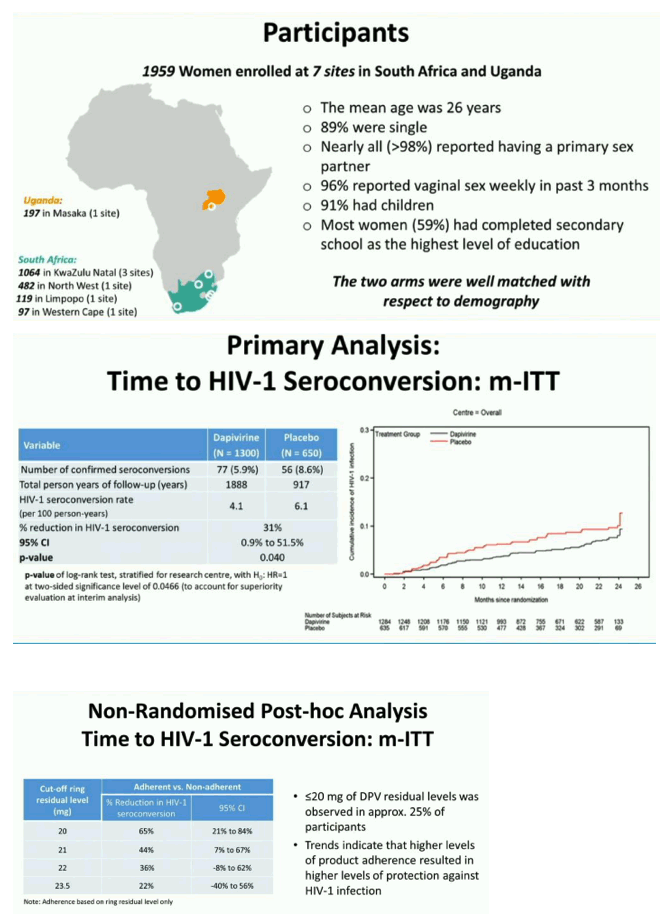
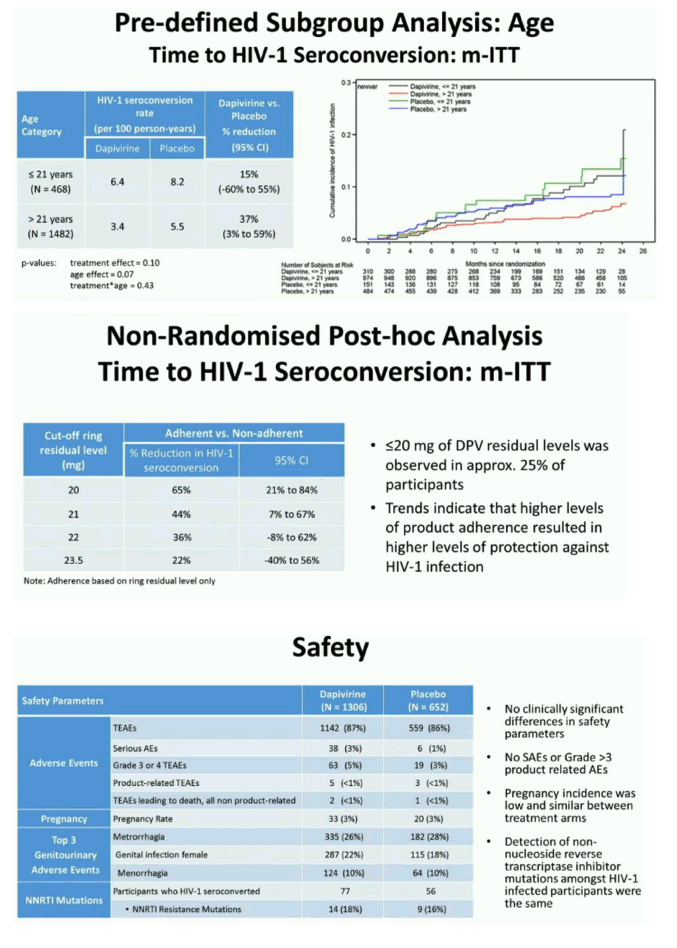
Program Abstract:
The monthly Dapivirine Vaginal Ring (DVR; 25 mg) was evaluated for safety and efficacy in two Phase III clinical trials, The Ring Study and ASPIRE. The trials demonstrated that the ring was safe and reduced the risk of HIV-1 infection in women, 18 to 45 years, by ≅ 30% relative to placebo. DREAM is an ongoing Phase IIIb, multi-center, open-label follow-on trial to The Ring Study to evaluate continued safety and adherence to ring use. The preliminary results are presented.
Women who participated in The Ring Study and who were HIV-negative at screening for DREAM were eligible for enrolment at 5 Research Centers (RCs) in South Africa and 1 in Uganda. Monthly RC visits take place up to 3 months after enrolment, whereafter participants continue on a quarterly visit schedule. HIV testing and safety evaluations are conducted at each visit, and used rings are returned for analysis of dapivirine residual levels. HIV-1 incidence was compared descriptively to the rate expected by bootstrap sampling, based on the placebo arm of The Ring Study, selecting 10,000 times for a subset of women matched for RC, age, and presence of a curable sexually transmitted infection (STI) at enrolment.
By September 2017, 900 women were enrolled in DREAM. The median age was 29 years (range: 20-50); 3% were ≤21, 24% were >21 and ≤25; 33% were >25 and ≤30; 21% were >30 and ≤35; and 19% were >35 years. A total of 11 HIV-1 seroconversions in 623 person-years (PY) of follow-up was observed on product: an incidence rate of 1.8 per 100 PY (95% CI: 0.9-3.2). Based on RC, age, and STI distribution of the population enrolled, HIV-1 incidence was expected to be 3.9 per 100 PY (95% CI: 2.9-4.9) in the absence of DVR use. An incidence of 1.8 per 100 PY would be expected to occur with a frequency of less than 1 in 10,000 samplings. Only 4% of returned rings had a residual level >23.5 mg, indicative of non-adherence to ring use, compared to 17% in The Ring Study. Eleven serious adverse events were reported, all unrelated to ring use.
Preliminary results from DREAM indicate a similar safety profile of DVR to that observed in Phase III. Based on dapivirine ring residual levels, adherence to ring use is higher. Although interpretation is limited by the lack of a placebo arm, the observed HIV-1 incidence rate is ≅ 54% lower than the expected rate in the absence of access to DVR, supporting the hypothesis that increased efficacy would occur when participants knew the DVR's safety and efficacy from Phase III.
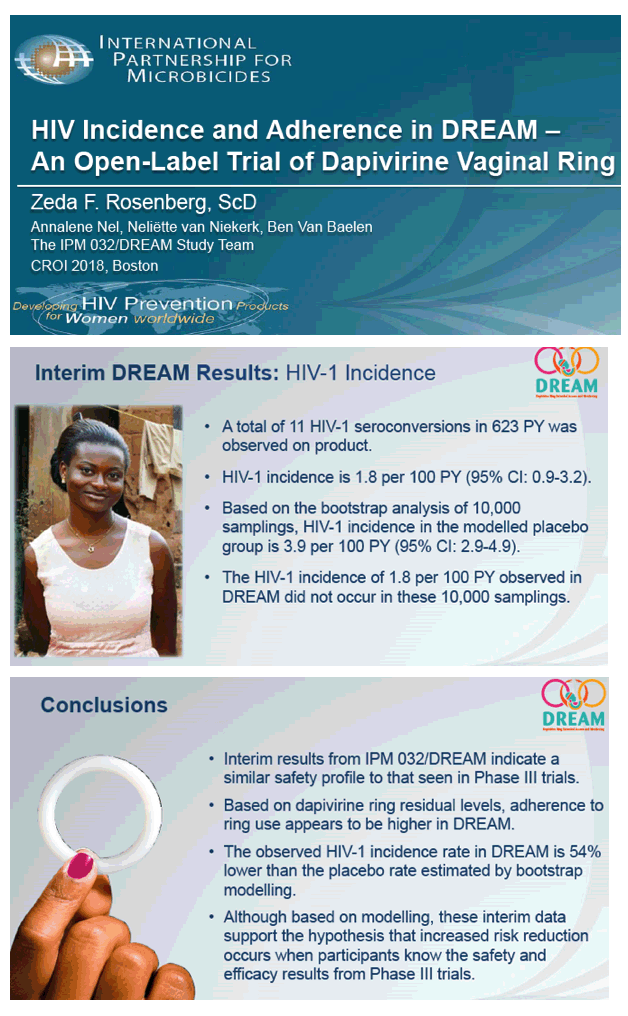
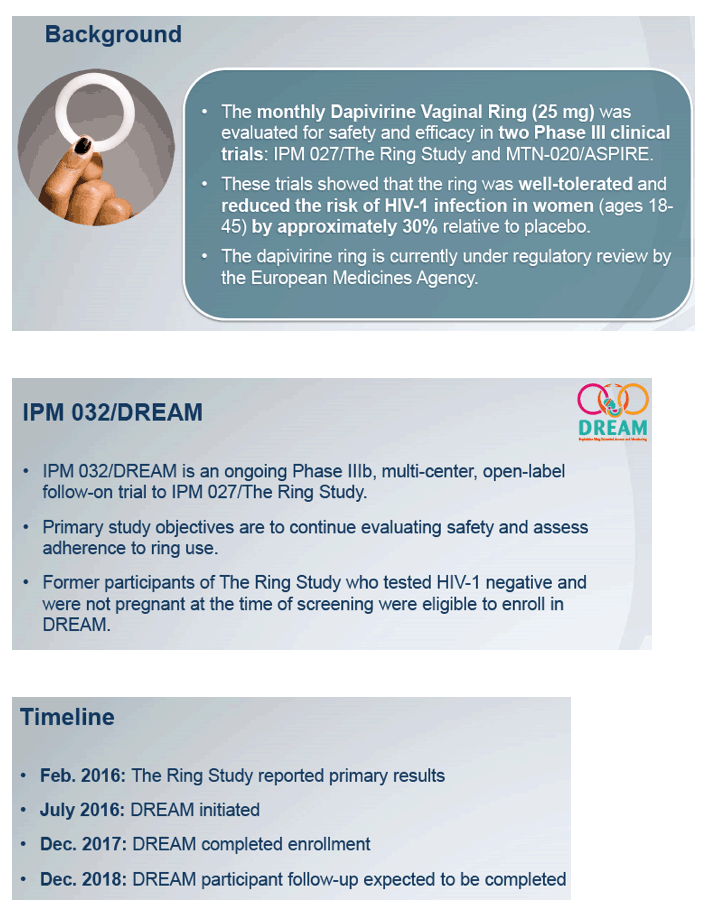

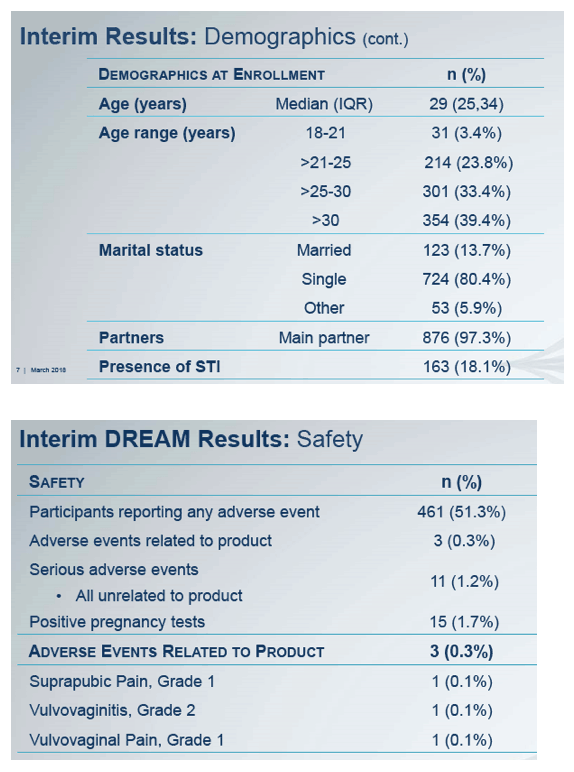
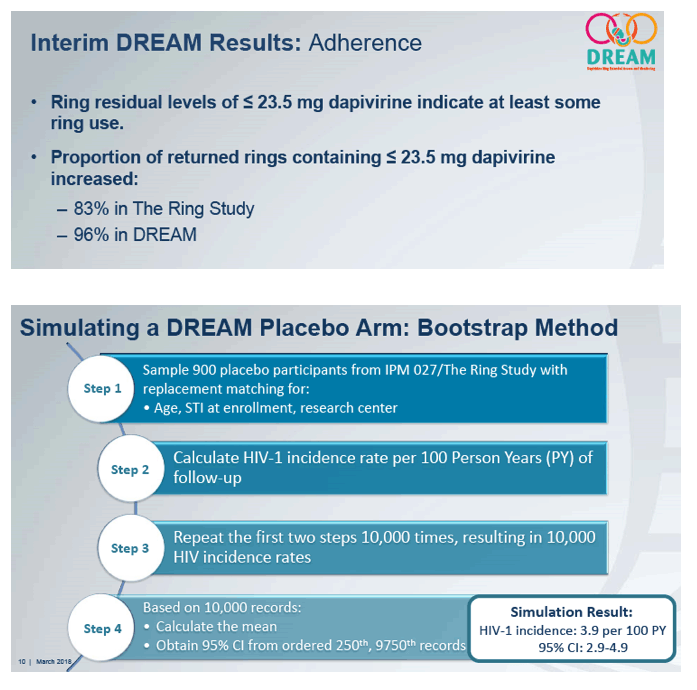
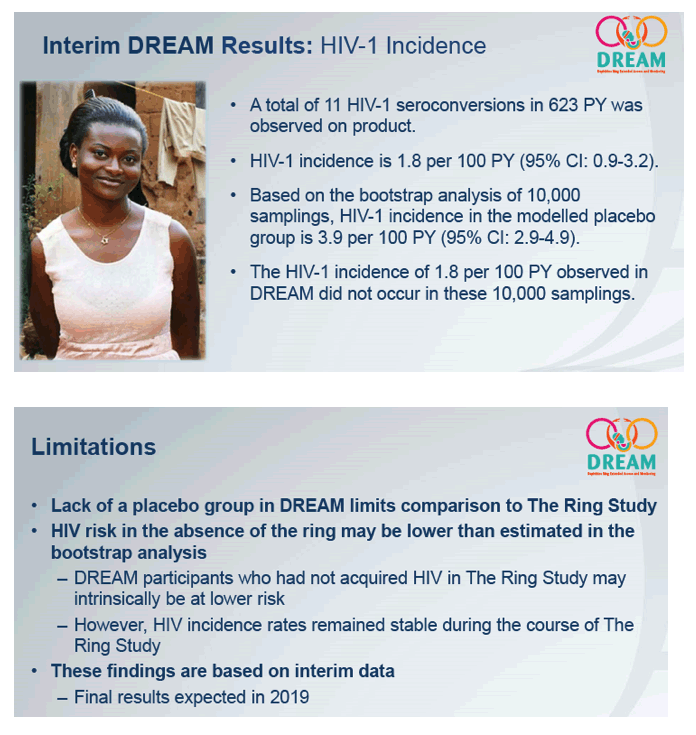
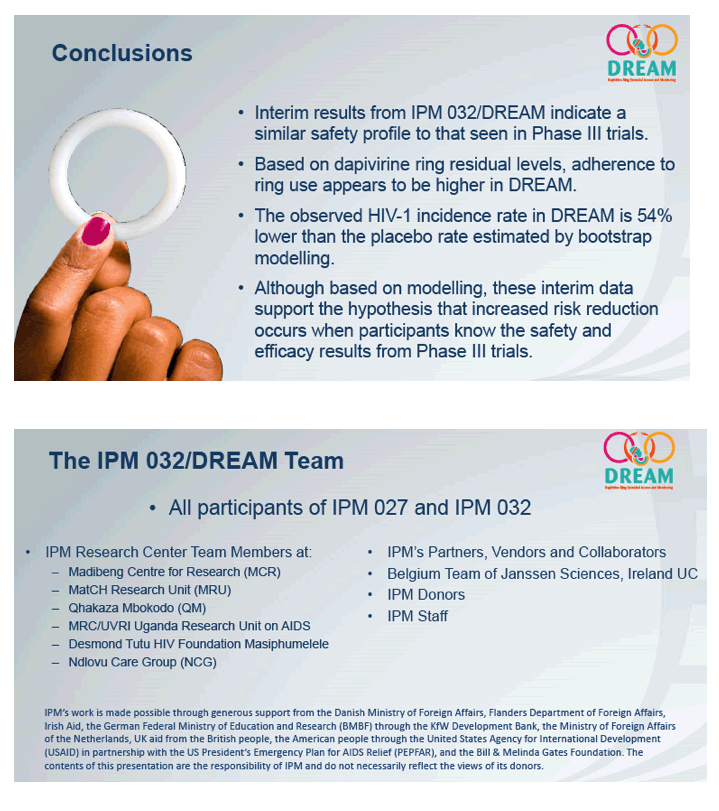
|
| |
|
 |
 |
|
|